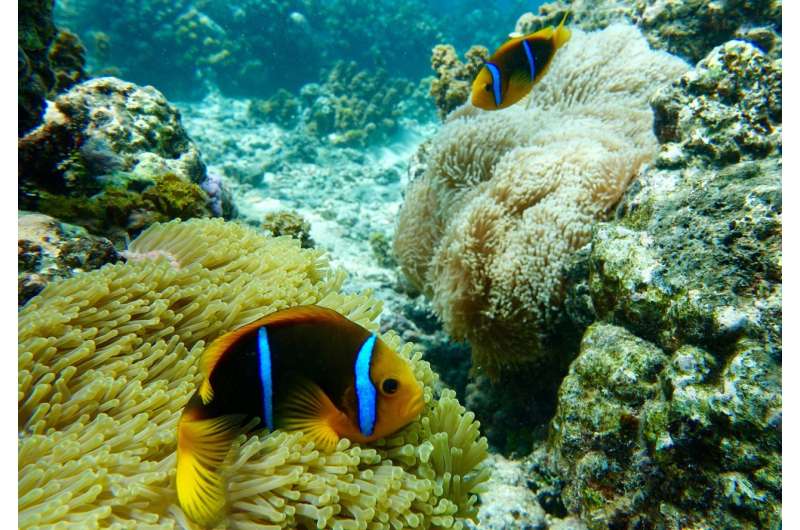When anemones bleach, clownfish suffer

Coral bleaching is a well-known consequence of climate change. What is less widely known is that sea anemones suffer the same fate, and this reduces the fertility of clownfish living in these anemones, as researchers from the CRIOBE, a laboratory jointly managed by the CNRS, the EPHE and Université de Perpignan Via Domitia, have just demonstrated in French Polynesia. Following a 14-month study, they are publishing their results in Nature Communications on Oct. 10, 2017.
Like corals, sea anemones live in symbiosis with microscopic algae, which gives them their color. Symbiotic clownfish protect themselves from predators by sheltering among the anemones' tentacles, and each month, lay eggs at their base. The anemones are also protected by the clownfish that they host.
Every other day, from October 2015 to December 2016, researchers and students visited 13 pairs of clownfish and their host anemones in the coral reefs of Moorea Island (French Polynesia). This monitoring was conducted before, during and after the 2016 El Niño event that triggered a warming of the Pacific Ocean (+2°C on Moorea Island compared to the 2007-2015 average—a combined effect of ongoing global warming and the El Niño episode) and a worldwide coral bleaching episode. Half of the anemones monitored in this study bleached as they lost their microalgae. Among the clownfish living in the bleached anemones, the scientists observed a drastic reduction in the number of viable eggs (-73 percent). These fish were laying eggs less frequently and they were also laying fewer and less viable eggs, while these parameters remained unchanged among fish hosted by unbleached anemones.
Blood samples taken from 52 pairs of clownfish (including the 13 previously mentioned) showed a sharp increase in the level of stress hormone cortisol, and a significant drop in concentrations of sex hormones (the equivalents of testosterone and oestrogen). The bleaching of the anemones due to increased sea surface temperatures is thus a stressor that reduces the levels of sex hormones and thus the fertility of the fish. These links have been found for the first time in the natural environment in which the fish live.
The health of the anemones and the fish improved between three and four months after the end of the warming event, long after temperatures had returned to normal. But would this have been the case had the warming episode been more intense, or longer? And faced with a new warming episode, will the clownfish that have already suffered this initial stress be better acclimatized, or more fragile? To provide some answers to these questions, the team will monitor each individual during the next El Niño episode. Such monitoring is possible due to the fact that clownfish have a fairly long life expectancy and are sedentary, seldom moving from their host anemone.
The clownfish are not an isolated case. Twelve percent of the coastal fish in French Polynesia depend on anemones or corals to feed or to find protection from predators. In cases of prolonged bleaching, like that of the Australian Great Barrier Reef in 2016 and 2017, the renewal of all of these populations could be affected, and with them, the stability of the ecosystems.
More information: Ricardo Beldade et al, Cascading effects of thermally-induced anemone bleaching on associated anemonefish hormonal stress response and reproduction, Nature Communications (2017). DOI: 10.1038/s41467-017-00565-w
Journal information: Nature Communications
Provided by CNRS


















